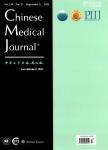A novel missense mutation, GGC(Arg454) → TGC(Cys), of CYP11B1 gene identified in a Chinese family with steroid 11β-hydroxylase deficiency
A novel missense mutation, GGC(Arg454) → TGC(Cys), of CYP11B1 gene identified in a Chinese family with steroid 11β-hydroxylase deficiency作者机构:Department of Endocrinology First Affiliated Hospital of Nanjing Medical University Nanjing Jiangsu 210029 China Shanghai Institute of Endocrinology and Metabolism Rui Jin Hospital Shanghai Jiao Tong University School of Medicine Shanghai 200025 China
出 版 物:《Chinese Medical Journal》 (中华医学杂志(英文版))
年 卷 期:2010年第123卷第10期
页 面:1264-1268页
核心收录:
学科分类:0710[理学-生物学] 071010[理学-生物化学与分子生物学] 082704[工学-辐射防护及环境保护] 081704[工学-应用化学] 07[理学] 08[工学] 0817[工学-化学工程与技术] 0827[工学-核科学与技术]
基 金:Jiangsu Provincial Core Departments Foundation [2001-31]
主 题:11 beta-hydroxylase CYP11B1 congenital adrenal hyperplasia
摘 要:Background Steroid 11β-hydroxylase deficiency (11β-OHD), an autosomal recessive inherited disease, accounts for 5%-8% of congenital adrenal hyperplasia. It was scarcely reported in China. This article reports two Chinese girls with 11β-OHD. Methods The two patients were sisters and presented with hypertrichosis, skin pigmentation, laryngeal prominence and virilization of external genitalia. The patients were followed up for their clinical symptoms and signs, hormone profile, and adrenal image. The genomic deoxyribonucleic acids of the patients and their parents were isolated. 11β-hydroxylase gene (CYP11B1) was amplified by polymerase chain reaction and directly sequenced. Results Hormone tests showed that serum cortisol was in the low limit of normal range, whereas the concentrations of adrenocorticotropic hormone, testosterone and progesterone were much higher than those of normal adult females. There were obvious adrenal hyperplasia and advance of bone age. After 11 months of treatment with dexamethasone, the skin pigment became regressed; the breast, uterus and ovary gradually developed and normal menstrual cycle started while the manifestations of virilization did not change. A single point mutation of CYP11B1 (R454C, GGC → TGC) in all the members of this family was detected. The sisters were homozygous and their parents were heterozygous. Conclusions The clinical manifestation of 11β-OHD is complicated. The manifestation of virilization could not regress after treatment with dexamethasone. The novel missense mutation of CYP11B1 (R454C, GGC → TGC) is the pathogenesis of 11β-OHD at least in some Chinese patients.



